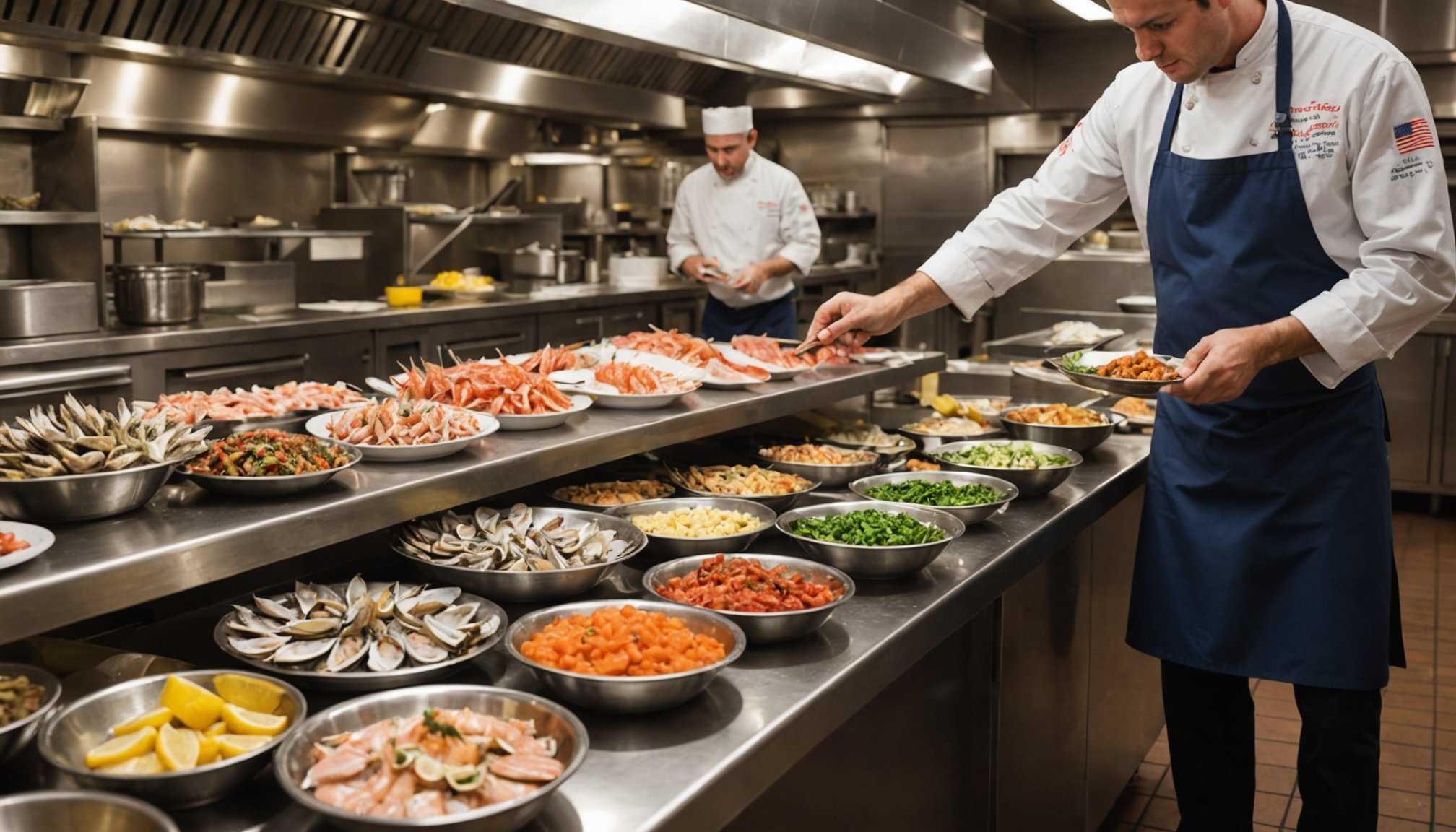Strategies for Maintaining Freshness in Raw Bars
Ensuring freshness in raw bars is crucial for providing a top-notch dining experience. It begins with sourcing high-quality seafood. Selecting suppliers known for seafood quality management ensures that the seafood arrives fresh and safe. The quality of sourced seafood significantly impacts freshness and customer satisfaction.
Temperature control is vital in preserving seafood freshness. Use refrigerated displays and maintain consistent temperatures to mitigate spoilage. Implement best practices by regularly monitoring and adjusting temperature settings, thereby prolonging the seafood’s freshness.
Topic to read : Essential Theft-Prevention Techniques for Your City Bar: Expert Security Advice for a Safe Venue
Maintaining hygiene through contamination control is another essential strategy. Minimize cross-contamination by employing separate utensils and cutting boards for different seafood types, thereby preventing the spread of bacteria. Regular sanitation of utensils and surfaces, along with encouraging proper staff hygiene, fortifies this strategy.
Additionally, training staff on these protocols reinforces the importance of maintaining freshness. Educating employees about the impact of handling techniques on seafood quality equips them for better seafood management, ensuring they contribute to an overall superior dining experience. By focusing on sourcing, temperature, and hygiene, raw bars can achieve and maintain exceptional freshness levels, delighting their customers.
Have you seen this : Craft an Irresistible Child-Friendly Menu: Proven Strategies to Delight Both Kids and Parents
Tools and Technologies for Freshness and Inventory Control
In the bustling world of raw bars, keeping seafood fresh while managing inventory efficiently is paramount. One significant advancement is the adoption of seafood monitoring tools. These technologies, such as digital temperature logs and freshness detectors, ensure seafood is stored under optimal conditions, thus enhancing quality and extending shelf life.
Integrating restaurant management software is highly beneficial for inventory oversight. These systems bridge the gap between ordering, sales, and stock levels, offering real-time insights and streamlined control. They also link with point-of-sale systems, which helps restaurants make informed decisions about seafood ordering and usage, thereby minimizing waste and overstock.
Innovations in food safety monitoring continue to emerge, pushing boundaries for inventory technology in raw bars. For example, smart sensors can now monitor humidity and gas levels around stored seafood, providing a comprehensive picture of freshness and storage conditions. This thorough approach ensures superior management and storage, safeguarding against spoilage.
By leveraging these tools and technologies, restaurants can maintain high standards of freshness while efficiently managing their inventory, ultimately leading to heightened customer satisfaction and operational success.
Staff Training and Educational Programs
Efficient Staff Training and well-designed Employee Education Programs are essential for maintaining the high standards of raw bars. Training plays a pivotal role in ensuring product quality and safety, particularly in highly sensitive environments like seafood service. By equipping staff with comprehensive knowledge about seafood handling, restaurants can significantly reduce the risk of foodborne illnesses and enhance customer trust.
Designing effective training programs tailored for both kitchen and service staff is crucial. These programs should include best practices in food safety, hygiene protocols, and up-to-date seafood sourcing methods. Providing employees with a clear understanding of such principles not only improves their performance but also contributes to the overall success of the raw bar.
Continual education ensures team members stay informed about the latest developments in seafood handling techniques and food safety standards. This ongoing process helps restaurants maintain consistency in service, adapt to regulatory changes, and improve the quality of their offerings. Empowering staff with knowledge and skills not only boosts their confidence but also enhances customer satisfaction, making staff training an indispensable component of successful raw bar management.
Customer Engagement and Feedback for Continuous Improvement
In the world of raw bars, customer feedback serves as a crucial tool for maintaining top-tier freshness standards and driving continuous improvement. By actively seeking out customer feedback, restaurants can assess the quality of their offerings and gain insights into areas needing enhancement.
Engaging customers can be achieved through various techniques such as comment cards, online surveys, and social media interactions. These methods encourage diners to share their experiences and suggestions on raw bar quality assurance. With this valuable information, restaurants can make informed adjustments that cater to their patrons’ preferences.
Furthermore, implementing systematic feedback processes allows for a seamless integration of customer inputs into operational strategies. This ensures that the dining experience evolves, meeting both current and future expectations. Restaurant customer engagement elevates the dining experience, making customers feel valued and heard.
Using feedback also plays a pivotal role in refining inventory practices and menu offerings. By aligning seafood selection and availability with customer preferences, raw bars can ensure maximum satisfaction. This proactive approach not only boosts customer loyalty but also strengthens the restaurant’s position in a competitive market. Customer engagement is, therefore, indispensable in driving success and innovation in raw bar management.
Effective Inventory Management Techniques for Busy Restaurants
In the hustle and bustle of high-traffic restaurant operations, effective inventory management is key to success. Implementing a real-time inventory tracking system provides enhanced visibility, allowing restaurants to streamline processes and ensure they always know exactly what’s in stock. This approach significantly reduces uncertainties and enhances operational efficiency.
For managing perishable inventory, strategies like FIFO (First In, First Out) are critical. This method helps reduce waste by using older stock first, thus minimizing spoilage. Perishable inventory demands careful attention, especially in busy restaurant settings, where speed and accuracy are paramount.
Data analytics takes inventory management a step further by predicting demand and optimizing stock levels. Using historical data and trends, restaurants can anticipate busy periods and adjust their order quantities accordingly, keeping inventory lean but sufficient.
Moreover, integrating these systems with existing point-of-sale technologies fosters a cohesive operation. With analytics at their fingertips, managers can make informed decisions to align inventory with menu offerings, avoiding surplus and shortages. By adopting these techniques, restaurants can maintain an agile inventory flow, ensuring freshness and waste reduction even in the most bustling environments.
Case Studies of Successful Restaurant Raw Bar Operations
In the realm of successful raw bar management, examining real-world examples illuminates best practices and strategies. One notable case study highlights a restaurant that excelled in freshness and customer satisfaction by implementing rigorous seafood quality management. By choosing top-tier suppliers and maintaining strict quality standards, they ensured that every serving was of the highest quality, leading to an unparalleled dining experience.
Insights from another high-traffic restaurant reveal how innovative inventory practices enhanced efficiency. This establishment significantly improved inventory turnover by integrating restaurant management software and employing data analytics to predict demand accurately. Their methodical approach resulted in reduced waste and ensured that menu items consistently reflected fresh and in-stock ingredients.
Additionally, lessons from industry leaders highlight the importance of maintaining a competitive edge through strategic insights. These leaders implemented tailored inventory management systems and embraced technology to refine operations, proving crucial for staying ahead in the competitive restaurant landscape.
These case studies collectively offer valuable takeaways for raw bars aiming for excellence. Emphasizing seafood quality management, proactive inventory strategies, and adopting advanced tools can significantly elevate restaurant performance and customer satisfaction.




